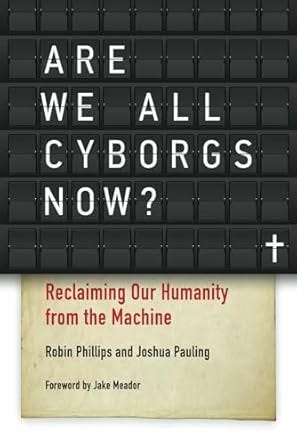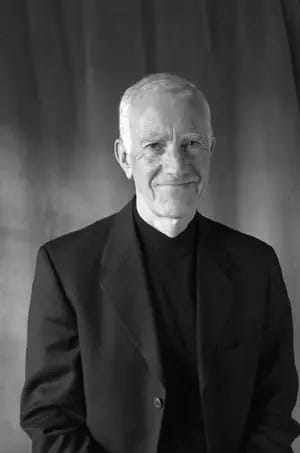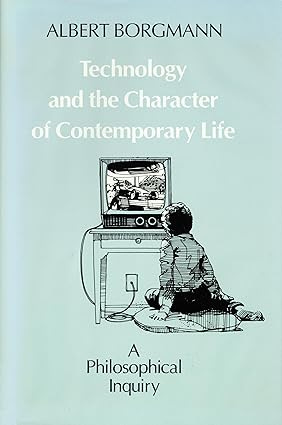We are witnessing a significant shift in public concern about the impacts of digital omnipresence on human life. The receipts continue to pile up regarding everything from rising anxiety to declining attention. Increasing numbers of people are now willing to acknowledge we have a problem. But what are we to do about it?
There are good contemporary sources being published with sound analysis and advice. But there are also vital resources from the past which can be fruitfully explored. A vast array of dead thinkers are just waiting to be heard – who not only warned of the effects of such technological changes, but also offered humane alternatives and frameworks for navigating this brave new world with poise and virtue. Tapping the likes of Neil Postman, Jacques Ellul, Ivan Illich, Joseph Wiezenbaum, and many others grants us a background for understanding what we are seeing today and fresh ideas for what we can do about it, for though they are dead, they still speak.
In our recent book Are We All Cyborgs Now? Reclaiming Our Humanity from the Machine, Robin Phillips and I mine the riches of past and present philosophers of technology to help us explore the far-reaching impact of omnipresent digitality, including its effects in the realm of society, family, religion, and education. But perhaps what makes our book somewhat unique is that we ground the whole discussion in anthropological and theological questions of what it means to be a human creature and what it means that God became man in the incarnation of Christ.
In recovering a Christ-centered anthropology, we have found ourselves drawing on a number of philosophers who, while not working in an explicitly theological framework, nevertheless help us better understand what it means to be fully human as material images of God. One such thinker is the philosopher Albert Borgmann, who died in 2023.
The Device Paradigm
Albert Borgmann grew up in Germany during the tumultuous years of World War II, eventually finding his way to America and landing a philosophy professorate at the University of Montana where he taught for fifty years. In over a half-century of scholarship, teaching, and research, with academic publications dating from the 1960s into the 2020s, one of Borgmann’s recurring interests was the interplay of humans and technology. His 1984 book Technology and the Character of Contemporary Life advances a clairvoyant analysis of our technological society. Long before personal computers or smart phones seemed plausible, Borgmann was already using the phrase “device paradigm” to describe our relationship to technology.
Borgmann argued that the device paradigm “reveals a fatal debilitating tendency in the present rule of technology.” He worried that modern technologies, already in the 1980s, were “forbiddingly complex and inaccessible,” so much so that we as humans don’t really know what to do with them. They are an abstraction and are not intuitive or understandable. He went on to further explain how devices “dissolve the coherent and engaging character of the pretechnological world of things.” In a device, Borgmann explains, “the relatedness of the world is replaced by a machinery, but the machinery is concealed, and the commodities, which are made available by a device, are enjoyed without the encumbrance of or the engagement with a context.”
There was a legibility to prior technologies and analog devices; their workings were visible, decipherable, and repairable by the average person. Not so in the age of high technology; everything is hidden, shrouded, mysterious. The severing of a tool from its function within the device paradigm is disorienting and desiccating for us and contributes to an increasing sense of alienation and decreasing sense of agency. John Dyer, author of From the Garden to the City, helps us better understand what Borgmann means by device: “Borgmann uses the word device in a very specific sense to refer to a tool that takes a long, difficult process for a human and makes it available at the press of a button or flip of a switch.”
One example Borgmann provides is the heating of our homes through central heating or furnaces. While this technology is a modern marvel and blessing to be sure, our simple pushing of the button or turning of the dial on the thermostat (or now via our smartphone or voice), hides and obscures the actual production of the heat that is taking place elsewhere. It abstracts the necessary activity from our sight, understanding, and action. Humans used to have to chop wood, start a fire, put wood in the wood stove, and so on to heat their home. Now we turn a knob or push a button—or it even just regulates itself. Borgmann is not saying we should get rid of central heating. He is simply pointing out that as the device paradigm extends further into every aspect of our lives, we lose out on opportunities for understanding the world and interacting with it bodily. Such abstracted and mediated interactions with our world and with each other shrink the margin for developing human agency and experiencing the deep satisfaction that comes from making tangible impact on physical stuff through embodied activity.
The device paradigm has extended even further as digital technologies have come to be overlayed more extensively on top of mechanical technologies in a form of technology stacking. Even our appliances, cars, and more, though they still function based on mechanical principles, are increasingly shrouded with digital interfaces and screens that further obscure their actual inner workings, and make their use more reliant on outside forces.
One might even argue that currently, an even higher zenith of the device paradigm is found in smartphones and other portable internet-connected digital devices we constantly use, which are literal black boxes that are capable of nearly endless use and operation, all of which is obscured behind the curtain of binary code, rare earth metals, smooth plastic, and frictionless glass. The digital interface of the smartphone or internet-connected computer is an omni-tool—it can tell you the weather, give you directions, answer your questions, be a portal to other virtual worlds, even be your companion. While there is certainly value in the powers such an omni-tool can wield, Borgmann’s concern remains: that as more and more of human life is experienced from within the device paradigm, that human skills and virtues are in danger of atrophying. And he wasn’t wrong.
It is interesting to muse on what Borgmann would think of the expansion of large language models like ChatGPT since his death in 2023. Might he see in such forms of AI the platonic ideal of the device paradigm, where via the “cloud” (a word that literally can mean to obscure or shroud) we are given answers to any question instantly on any screen we want? Meanwhile, the mountains of data analyzed to generate such responses are never made visible, nor are the human programmers who wrote the code, nor are the humans who “trained” the AI, nor are the massive amounts of energy consumed in the process.
Focal Practices
To counter the device paradigm, Borgmann suggests the recovery of focal things and focal practices. A focal practice “is one that can center and illuminate our lives” because it is some sort of activity that engages us with the world and with each other, requiring the exercise and development of skill, and our full attention and presence in real time and space with real things and real people. He further explains:
Countering technology through a practice is to take account of our susceptibility to technological distraction, and it is also to engage the peculiarly human strength of comprehension, i.e., the power to take in the world in its extent and significance and to respond through an enduring commitment.
To flesh out the difference between the device paradigm and focal practices, Borgmann considers music. Music can be a focal practice “if it is alive as a regular and skillful engagement of body and mind and if it graces us in a full and final way.” Participating in the creation of live music by playing an instrument or singing “challenges humans to develop and exercise the finest bodily movements of which they are capable.”
This communal experience of live music is rich, even primal, and has for millennia accompanied the most joyous, mournful, and even mundane occasions of the human life. However, under the device paradigm, our relationship to music is profoundly changed. Not only can we listen to music without creating it, the technologies we employ to do so are incomprehensible, invisible, and individual. Just ponder for a moment the significant experiential differences of listening to live music together, listening to a vinyl record in the living room from beginning to end, and listening to an algorithmically generated Spotify playlist with earbuds. Each change isolates the creation or practice of music from its consumption, and generates a shift away from music as something to be created and received in community, towards music as something to be controlled and consumed in isolation. Such shifts in how we experience music are illustrative of the broader dangers of the device paradigm and how it tends to foreclose opportunities for focal practices, which are central to human joy and fulness.
To counteract the conditions of techno-modernity, Borgmann also suggests additional focal practices around Word and Table. Surrounded by screens and easy entertainment, spending time reading books or reading aloud as a family can be meaningful focal practices. Similarly, eating meals together, inviting people into your home, celebrating together, and keeping devices away from the table brings us closer to full presence with each other.
More Wisdom from Borgmann
Three more points are worth mentioning, where Borgmann’s wisdom is particularly relevant today.
1. Embrace Burdens
The digital world trains us to avoid burdens and friction and gives us the false impression that life can be lived without such things. Borgmann reminds us that we should not forsake all burdens; some burdens are wonderfully rich and rewarding as part of being limited creatures situated in interdependent relationships with others.
Consider, for instance, the burden of preparing a meal and getting everyone to show up at the table and sit down. Or the burden of reading poetry to one another or going for a walk after dinner. Or the burden of letter-writing – gathering our thoughts, setting them down in a way that will be remembered and cherished and perhaps passed on to our grandchildren. These are the activities that have been obliterated by the readily available entertainment offered by TV. The burdensome part of these activities is actually just the task of getting across a threshold of effort. As soon as you have crossed the threshold, the burden disappears.
(For more about burdens and the therapeutic power of hardship, see Robin Phillips’ article “How We Are Raising Fragile Children…and Why Pain isn’t Always Bad” and post “Why hardship isn’t Always Bad.”)
2. Consider Thresholds
Borgmann suggests that we reduce the threshold into such meaningful activities and increase the threshold into less-meaningful activities that are frequently mediated to us through a device.
[We need] to help people put reasonable bounds on their use of these devices. But my focus is less on setting limits than it is on creating the positive conditions in which technology becomes less compelling and different kinds of engagements thrive and flourish. How we situate technological devices in our homes is morally significant. Placing the television in an inconvenient location in one’s home removes it from a position of constant availability and makes room for other engagements to flourish. With this kind of physical rearrangement must come a reengagement with what I call focal things and practices.
Borgmann laments that the “threshold to Nintendo games and television shows is low, and so you move across that threshold easily. The rewards from that are low as well.” Conversely, Borgmann notes,
focal things and practices have a high threshold. The threshold is high morally not materially. It’s not as if people have to exert themselves strenuously or face some danger before they can sit down at the table. It’s right there, within reach. But there is a moral threshold. It’s a bother, It’s a pain. There is a high threshold, and so it’s difficult to get across it. But once you’re across it the reward is high as well. After a fine meal you get up with a glad heart. After playing tennis with your kid for a couple of hours both of you feel good. Obviously, you have to begin with your children when they’re small, and then you have to live and practice for them the thing that you love. And then they’ll take it up as well.
This is certainly an uphill climb, but it is worth it, especially when it is rooted in love; not in what we are against, but what we are for. Borgmann encourages parents to “love what they make a focal thing and practice,” because “if you love it, your children learn to love it. What children best remember from their childhood and most likely re-create in their adult life is what their parents loved.”
3. Return Digital Devices Back to the Tool Paradigm
Another way to apply Borgmann’s device paradigm is to take digital devices out of the device paradigm and return them to the tool paradigm, where they function primarily for one use at a time and then are put down. Digital devices so easily bleed over into everything else and give us the impression that we can multitask successfully. But if we think of them more as tools for specific tasks, we can also reduce some of our listless distractions and purposeless use.
Borgmann grew up in an age of technological progress and optimism, yet he came to question its underlying assumptions and warned of the patterns and habits of living that form us in such a technological society. As Borgmann put it, “computers, television and cars are all part of technology. But technological items and procedures coalesce into a culture, a way of life.” And it is this way of life that Borgmann offered some alternatives to: strategies for maintaining havens of humanity, building fortresses of freedom, impenetrable to the techno-tentacles of the ubiquitous device and screen. With Borgmann’s recent death in May of 2023, let’s carry on his legacy in our little acts of resistance through which something meaningful takes shape in our own lives, in the lives of our families, churches, and communities.
The above is a modified excerpt from chapter 17 of Are We All Cyborgs Now? Reclaiming Our Humanity from the Machine.
Further Reading









